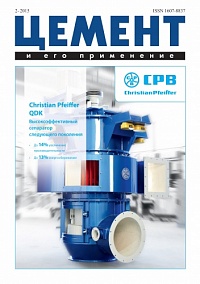The paper describes the results of the analysis of ground raw materials moving on the air slide made with SpectraFlow inline analyzers controlled by the software automatically adjusting the setpoints of weight feeders, at the Kipaş Cement factory, Turkey. SpectraFl...
The article describes the advantages of in-line prompt gamma neutron activation analysis, PGNAA, compared with other methods of determining the chemical composition of materials in cement manufacturing. Data on the improvement of the stability of the raw meal chemical c...
In October 2014, Siemens released a new version of specialized software for the automation of various production areas in the cement industry - Cemat V8.1. Many of the innovations in this already tested and time-proven automation system based on the distributed SIEMENS ...
Porous surfaces of cement concrete (OPB) or asphalt concrete (OPA) have a permanent transfer of rainwater and additionally a noise reduction potential compared to the dense microstructure with exposed aggregates concrete.
Previous concrete test sections ...
In Q1, 2015 1408,4 kt of cement and 804 kt of clinker were produced, or, respectively 1.1 % and 9,9 % less than in the same period for 2014. In March 2015 there were produced 10,4 % of cement and 1,4 % of clinker less than in March 2014. In Q1, 2015 the ...
On May 26–29, 2015 the 6th International Conference UkrCemFor organized by the Ukranian Association of Cement Industry Enterprises and Organizations (Ukr-Cement) was held in Kiev. The conference attracted 96 delegates from Ukraine, Russia and 10 other countries....
Rheological properties of mortar and concrete can be controlled by the mixing regime, the environmental conditions as well as the adjustment of cement and superplasticizer and the dosage time of the agent. The present work presents the influence of a delayed addition of...
The article discusses the influence of complex metakaolin-containing additives, on cement hydration and forming of structure and properties of cement rock and concrete. It was found that metakaolin is an effective accelerator of cement hydration, but its use in large do...
The current trends in production of alkali-activated binders and of concrete on their basis are discussed. An attempt at classification of alkali-activated binders is made. The data on the effect of heat-treated rice husk (HTRH) on the normal thickness of cement...
Comparative studies of the effect of addition to Portland cement of polymineral clay glinite with kaolinite content of 51%, calcined at a temperature of 400-800° C, and ground to a specific surface of 250-800 m2/kg, and metakaolin with a specific surface area of 1,2...
| Author: R.Z. Rakhimov, N.R. Rakhimova, A.R. Gaifullin |
| Section: Science and production |
| Keywords: pozzolana, additive, multimineral clay, metakaolin, temperature, calcination, the specific surface area, Portland cement, hardened cement paste, strength |





